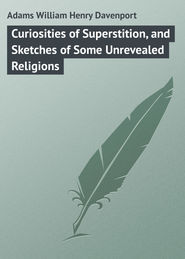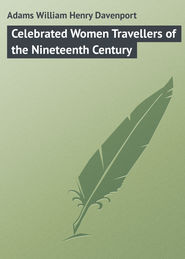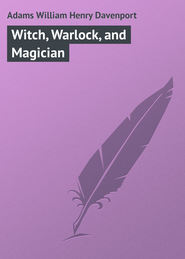По всем вопросам обращайтесь на: info@litportal.ru
(©) 2003-2024.
✖
Witch, Warlock, and Magician
Настройки чтения
Размер шрифта
Высота строк
Поля
D. Well, but when they were all gone, you came to yourself again, I suppose?
C. To tell you the truth, master, I am not come to myself yet.
D. But go on, let me know how it ended.
C. Why, after a little while, my old man came in again, called his man to set the chairs to rights, and then sat him down at the table, spoke cheerfully to me, and asked me if I would drink, which I refused, though I was a-dry indeed. I believe the fright had made me dry; but as I never had been used to drink with the devil, I didn’t know what to think of it, so I let it alone.
In his third chapter (‘Of the present pretences of the Magicians; how they defend themselves; and some examples of their practice’) Defoe has a lively account of a contemporary magician, a Dr. Bowman, of Kent, who seems to have been a firm believer in what is now called Spiritualism. He was a green old man, who went about in a long black velvet gown and a cap, with a long beard, and his upper lip trimmed ‘with a kind of muschato.’ He strongly repudiated any kind of correspondence or intercourse with the devil; but hinted that he derived much assistance from the good spirits which people the invisible world. After dwelling on the follies of the learned, and the superstitions of the ignorant, this lordly conjurer said: ‘You see how that we, men of art, who have studied the sacred sciences, suffer by the errors of common fame; they take us all for devil-mongers, damned rogues, and conjurers.’
The fourth chapter discusses the doctrine of spirits as it is understood by the magicians; how far it may be supposed there may be an intercourse with superior beings, apart from any familiarity with the devil or the spirits of evil; with a transition to the present times.
And so much for the ‘Art of Magic’ as expounded by Daniel Defoe.
In 1718 appeared Bishop Hutchinson’s ‘Historical Essay concerning Witchcraft,’ a book written in a most liberal and tolerant spirit, and, at the same time, with so much comprehensiveness and exactitude, that later writers have availed themselves freely of its stores.
Reference may also be made to —
John Beaumont, ‘Treatise of Spirits, Apparitions, Witchcrafts, and other Magical Practices,’ 1705.
James Braid (of Manchester), ‘Magic, Witchcraft, Animal Magnetism, Hypnotism, and Electro-Biology’ (1852), in which there is very little about witchcraft, but a good deal about the influence of the imagination.
J. C. Colquhoun, ‘History of Magic, Witchcraft, and Animal Magnetism,’ 1851.
Rev. Joseph Glanvill, ‘Sadducismus Triumphatus; or, A full and plain Evidence concerning Witches and Apparitions,’ 1670.
Sir Walter Scott, ‘Letters on Demonology and Witchcraft,’ 1831.
Howard Williams, ‘The Superstitions of Witchcraft,’ 1865.
It may be a convenience to the reader if I indicate some of the principal foreign authorities on this subject. Such as – Institor and Sprenger’s great work, ‘Malleus Maleficarum’ (Nuremberg, 1494); The monk Heisterbach’s (Cæsarius) ‘Dialogus Miraculorum’ (ed. by Strange), 1851; Cannaert’s ‘Procès des Sorcières en Belgique,’ 1848; Dr. W. G. Soldan’s ‘Geschichte der Hexenprocesse’ (1843); G. C. Horst’s ‘Zauber-Bibliothek, oder die Zauberei, Theurgie und Mantik, Zauberei, Hexen und Hexenprocessen, Dämonen, Gespenster und Geistererscheinungen,’ in 6 vols., 1821 – a most learned and exhaustive work, brimful of recondite lore; Collin de Plancy’s ‘Dictionnaire Infernal; ou Répertoire Universel des Etres, des Livres, et des Choses qui tiennent aux Apparitions, aux Divinations, à la Magie,’ etc., 1844; Michelet’s ‘La Sorcière’ is, of course, brilliantly written; R. Reuss’s ‘La Sorcellerie au xvi
. et xvii
. Siècle,’ 1872; Tartarotti’s ‘Del Congresso Notturno delle Lamie,’ 1749; F. Perreaud’s ‘Demonologie, ou Traité des Démons et Sorciers,’ 1655; H. Boguet’s ‘Discours des Sorciers,’ 1610 (very rare); and Cotton Mather’s ‘Wonders of the Invisible World,’ 1695 – a monument of credulity, prejudice, and bigotry.
BOOKS ON MAGIC
It may also be convenient to the reader if I enumerate a few of the principal authorities on the history of Magic, Sorcery, and Alchemy. A very exhaustive list will be found in the ‘Bibliotheca Magica et Pneumatica,’ by Graessel, 1843; and an ‘Alphabetical Catalogue of Works on Hermetic Philosophy and Alchemy’ is appended to the ‘Lives of Alchemystical Philosophers,’ by Arthur Edward Waite, 1888. For ordinary purposes the following will be found sufficient: Langlet du Fresnoy, ‘Histoire de la Philosophie Hermétique,’ 1742; Gabriel Naudé, ‘Apologie pour les Grands Hommes faussement soupçonnés de Magie,’ 1625; Martin Antoine Delrio, ‘Disquisitionum Magicarum, libri sex,’ 1599; L. F. Alfred Maury, ‘La Magie et l’Astrologie dans l’Antiquité et au Moyen Age,’ etc., 1860; Eus. Salverte, ‘Sciences Occultes,’ ed. by Littré, 1856 (see the English translation, ‘Philosophy of Magic,’ with Notes by Dr. A. Todd Thomson, 1846); Abbé de Villars, ‘Entretiens du Comte de Gabalis’ (‘Voyages Imaginaires,’ tome 34), Englished as ‘The Count de Gabalis: being a diverting History of the Rosicrucian Doctrine of Spirits,’ etc., 1714; Elias Ashmole, ‘Theatrum Chemicum Britannicum;’ Roger Bacon, ‘Mirror of Alchemy,’ 1597; Louis Figuier, ‘Histoire de l’Alchimie et les Alchimistes,’ 1865; Arthur Edward Waite, ‘The Real History of the Rosicrucians,’ 1887; Hargrave Jennings, ‘The Rosicrucians,’ new edit.; William Godwin, ‘Lives of the Necromancers,’ 1834; Dr. T. Thomson, ‘History of Chemistry,’ 1831; ‘Encyclopædia Britannica,’ in locis; Dr. Kopp, ‘Geschichte der Chemie;’ G. Rodwell, ‘Birth of Chemistry,’ 1874; Haerfor, ‘Histoire de la Chimie,’ etc., etc.
notes
1
Cf. Stahl, ‘Fundamenta Chimiæ,’ cap. ‘De Lapide Philosophorum’; and Kircher, ‘Mundus Subterraneus.’
2
Epistola Fratris Rogerii Baconis de Secretis Operibus Artis et Naturæ et de Nullitate Magiæ.
3
Laches, oversight.
4
This patriotic sentiment would seem to show that the book was written or published about the time of the Spanish Armada.
5
Hermes Trismegistus (‘thrice great’), a fabulous Chaldean philosopher, to whom I have already made reference. The numerous writings which bear his name were really composed by the Egyptian Platonists; but the mediæval alchemists pretend to recognise in him the founder of their art. Gower, in his ‘Confessio Amantis,’ says:
Of whom if I the namès calle,
Hermes was one the first of alle,
To whom this Art is most applied.’
The name of Hermes was chosen because of the supposed magical powers of the god of the caduceus.
6
That is, costard, or apple, mongers.
7
See Appendix to the present chapter, p. 58 (#Page_58).
8
The pentageron, or pentagramma, is a mystic figure produced by prolonging the sides of a regular pentagon till they intersect one another. It can be drawn without a break in the drawing, and, viewed from five sides, exhibits the form of the letter A (pent-alpha), or the figure of the fifth proposition in Euclid’s First Book.
9
From the Greek φόβος, fear; φόβητρα, bugbears.
10
Bad puns were evidently common on the stage before the days of Victorian burlesque.
11
So Shakespeare, ‘1 Hen. IV.,’ iii. Falstaff says: ‘I make as good use of it as many a man doth of a death’s head, or a memento house.’
12
So in the ‘Passionate Pilgrim’:
‘Save the nightingale alone:
She, poor bird, as all forlorn,
Leaned her breast uptill a thorn.’
C. To tell you the truth, master, I am not come to myself yet.
D. But go on, let me know how it ended.
C. Why, after a little while, my old man came in again, called his man to set the chairs to rights, and then sat him down at the table, spoke cheerfully to me, and asked me if I would drink, which I refused, though I was a-dry indeed. I believe the fright had made me dry; but as I never had been used to drink with the devil, I didn’t know what to think of it, so I let it alone.
In his third chapter (‘Of the present pretences of the Magicians; how they defend themselves; and some examples of their practice’) Defoe has a lively account of a contemporary magician, a Dr. Bowman, of Kent, who seems to have been a firm believer in what is now called Spiritualism. He was a green old man, who went about in a long black velvet gown and a cap, with a long beard, and his upper lip trimmed ‘with a kind of muschato.’ He strongly repudiated any kind of correspondence or intercourse with the devil; but hinted that he derived much assistance from the good spirits which people the invisible world. After dwelling on the follies of the learned, and the superstitions of the ignorant, this lordly conjurer said: ‘You see how that we, men of art, who have studied the sacred sciences, suffer by the errors of common fame; they take us all for devil-mongers, damned rogues, and conjurers.’
The fourth chapter discusses the doctrine of spirits as it is understood by the magicians; how far it may be supposed there may be an intercourse with superior beings, apart from any familiarity with the devil or the spirits of evil; with a transition to the present times.
And so much for the ‘Art of Magic’ as expounded by Daniel Defoe.
In 1718 appeared Bishop Hutchinson’s ‘Historical Essay concerning Witchcraft,’ a book written in a most liberal and tolerant spirit, and, at the same time, with so much comprehensiveness and exactitude, that later writers have availed themselves freely of its stores.
Reference may also be made to —
John Beaumont, ‘Treatise of Spirits, Apparitions, Witchcrafts, and other Magical Practices,’ 1705.
James Braid (of Manchester), ‘Magic, Witchcraft, Animal Magnetism, Hypnotism, and Electro-Biology’ (1852), in which there is very little about witchcraft, but a good deal about the influence of the imagination.
J. C. Colquhoun, ‘History of Magic, Witchcraft, and Animal Magnetism,’ 1851.
Rev. Joseph Glanvill, ‘Sadducismus Triumphatus; or, A full and plain Evidence concerning Witches and Apparitions,’ 1670.
Sir Walter Scott, ‘Letters on Demonology and Witchcraft,’ 1831.
Howard Williams, ‘The Superstitions of Witchcraft,’ 1865.
It may be a convenience to the reader if I indicate some of the principal foreign authorities on this subject. Such as – Institor and Sprenger’s great work, ‘Malleus Maleficarum’ (Nuremberg, 1494); The monk Heisterbach’s (Cæsarius) ‘Dialogus Miraculorum’ (ed. by Strange), 1851; Cannaert’s ‘Procès des Sorcières en Belgique,’ 1848; Dr. W. G. Soldan’s ‘Geschichte der Hexenprocesse’ (1843); G. C. Horst’s ‘Zauber-Bibliothek, oder die Zauberei, Theurgie und Mantik, Zauberei, Hexen und Hexenprocessen, Dämonen, Gespenster und Geistererscheinungen,’ in 6 vols., 1821 – a most learned and exhaustive work, brimful of recondite lore; Collin de Plancy’s ‘Dictionnaire Infernal; ou Répertoire Universel des Etres, des Livres, et des Choses qui tiennent aux Apparitions, aux Divinations, à la Magie,’ etc., 1844; Michelet’s ‘La Sorcière’ is, of course, brilliantly written; R. Reuss’s ‘La Sorcellerie au xvi
. et xvii
. Siècle,’ 1872; Tartarotti’s ‘Del Congresso Notturno delle Lamie,’ 1749; F. Perreaud’s ‘Demonologie, ou Traité des Démons et Sorciers,’ 1655; H. Boguet’s ‘Discours des Sorciers,’ 1610 (very rare); and Cotton Mather’s ‘Wonders of the Invisible World,’ 1695 – a monument of credulity, prejudice, and bigotry.
BOOKS ON MAGIC
It may also be convenient to the reader if I enumerate a few of the principal authorities on the history of Magic, Sorcery, and Alchemy. A very exhaustive list will be found in the ‘Bibliotheca Magica et Pneumatica,’ by Graessel, 1843; and an ‘Alphabetical Catalogue of Works on Hermetic Philosophy and Alchemy’ is appended to the ‘Lives of Alchemystical Philosophers,’ by Arthur Edward Waite, 1888. For ordinary purposes the following will be found sufficient: Langlet du Fresnoy, ‘Histoire de la Philosophie Hermétique,’ 1742; Gabriel Naudé, ‘Apologie pour les Grands Hommes faussement soupçonnés de Magie,’ 1625; Martin Antoine Delrio, ‘Disquisitionum Magicarum, libri sex,’ 1599; L. F. Alfred Maury, ‘La Magie et l’Astrologie dans l’Antiquité et au Moyen Age,’ etc., 1860; Eus. Salverte, ‘Sciences Occultes,’ ed. by Littré, 1856 (see the English translation, ‘Philosophy of Magic,’ with Notes by Dr. A. Todd Thomson, 1846); Abbé de Villars, ‘Entretiens du Comte de Gabalis’ (‘Voyages Imaginaires,’ tome 34), Englished as ‘The Count de Gabalis: being a diverting History of the Rosicrucian Doctrine of Spirits,’ etc., 1714; Elias Ashmole, ‘Theatrum Chemicum Britannicum;’ Roger Bacon, ‘Mirror of Alchemy,’ 1597; Louis Figuier, ‘Histoire de l’Alchimie et les Alchimistes,’ 1865; Arthur Edward Waite, ‘The Real History of the Rosicrucians,’ 1887; Hargrave Jennings, ‘The Rosicrucians,’ new edit.; William Godwin, ‘Lives of the Necromancers,’ 1834; Dr. T. Thomson, ‘History of Chemistry,’ 1831; ‘Encyclopædia Britannica,’ in locis; Dr. Kopp, ‘Geschichte der Chemie;’ G. Rodwell, ‘Birth of Chemistry,’ 1874; Haerfor, ‘Histoire de la Chimie,’ etc., etc.
notes
1
Cf. Stahl, ‘Fundamenta Chimiæ,’ cap. ‘De Lapide Philosophorum’; and Kircher, ‘Mundus Subterraneus.’
2
Epistola Fratris Rogerii Baconis de Secretis Operibus Artis et Naturæ et de Nullitate Magiæ.
3
Laches, oversight.
4
This patriotic sentiment would seem to show that the book was written or published about the time of the Spanish Armada.
5
Hermes Trismegistus (‘thrice great’), a fabulous Chaldean philosopher, to whom I have already made reference. The numerous writings which bear his name were really composed by the Egyptian Platonists; but the mediæval alchemists pretend to recognise in him the founder of their art. Gower, in his ‘Confessio Amantis,’ says:
Of whom if I the namès calle,
Hermes was one the first of alle,
To whom this Art is most applied.’
The name of Hermes was chosen because of the supposed magical powers of the god of the caduceus.
6
That is, costard, or apple, mongers.
7
See Appendix to the present chapter, p. 58 (#Page_58).
8
The pentageron, or pentagramma, is a mystic figure produced by prolonging the sides of a regular pentagon till they intersect one another. It can be drawn without a break in the drawing, and, viewed from five sides, exhibits the form of the letter A (pent-alpha), or the figure of the fifth proposition in Euclid’s First Book.
9
From the Greek φόβος, fear; φόβητρα, bugbears.
10
Bad puns were evidently common on the stage before the days of Victorian burlesque.
11
So Shakespeare, ‘1 Hen. IV.,’ iii. Falstaff says: ‘I make as good use of it as many a man doth of a death’s head, or a memento house.’
12
So in the ‘Passionate Pilgrim’:
‘Save the nightingale alone:
She, poor bird, as all forlorn,
Leaned her breast uptill a thorn.’










